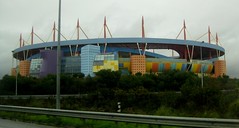
It is surely an unpopular topic when so much national pride seems to be placed on large international soccer tournaments, but while everyone is high-fiving each other or fuming about their team being eliminated, there is a tremendous cost for all this fanfare. Who bares this cost? How much is it? Why is it so expensive?
Few are brave enough to ask these questions, to question such a loved and long-running tradition is surely a risky dinner conversation. In an era where sustainability is so vital to the future of our existence on this planet, fans don’t seem to care if this applies in the context of the sports. But what if they knew the truth about their beautiful game?
In a future post I will get into South Africa and Germany, the current and most recent host of the World Cup. But since I have a personal connection to the Portuguese republic, I’d like to take you back their massive soccer tournament Euro2004. In this case, not to go back to the highlights of what player did what unbelievable thing, but to go back to what was built, invested, loaned, and promised then as compared to how things are now.
Let’s do it by the numbers:
- 6 cities, 6 new stadiums
- Total cost of 6 projects – 445 million euros.
- Total cost of these stadiums to these cities annually 19.9 million euros.
- City of Leiria pays 5 million per year in interest alone
- Aveiro, a city with around 73,600 inhabitants, has a new stadium with a capacity of 30,000.
- Mayor of Aveiro once suggested blowing up their stadium, which costs 4 million per year in loans and maintenance.
- Algarve’s stadium, capacity 30,000+ costing over 3.1 million annually, does not have a team in the 1st division of Portugal’s national soccer league.
- Cities of Leiria, Aveiro, and Faro are all hoping to sell their stadiums.
- The city of Braga is now expanding their previously expanded stadium in hopes of qualifying for a Spain-Portugal World Cup Bid. They pay 6 million euros in loans annually
Ok so that wasn’t just by the numbers. Because beyond the numbers, both the lack of use of these massive structures, and the tremendous cost burden for municipalities who openly want to rid themselves of these problems, indicates that when all is said and done the beautiful game has a financially crippling effect.
Yet the big name sponsors and FIFA would like you to ignore the man behind the curtain. Ignore the elephant in the room. Relax and enjoy the game, everything is fine.
Next up: Germany 2006, perhaps a better case?